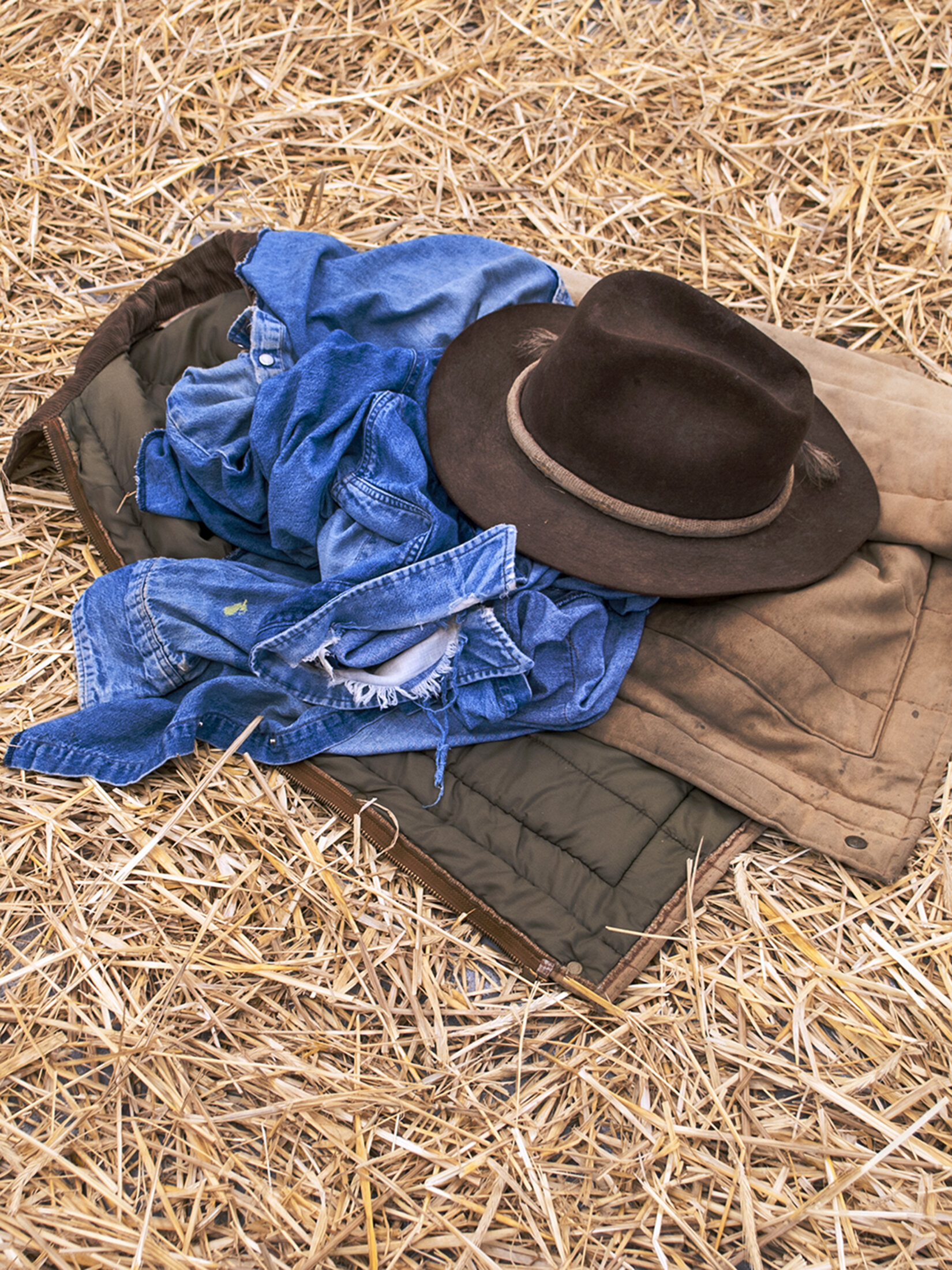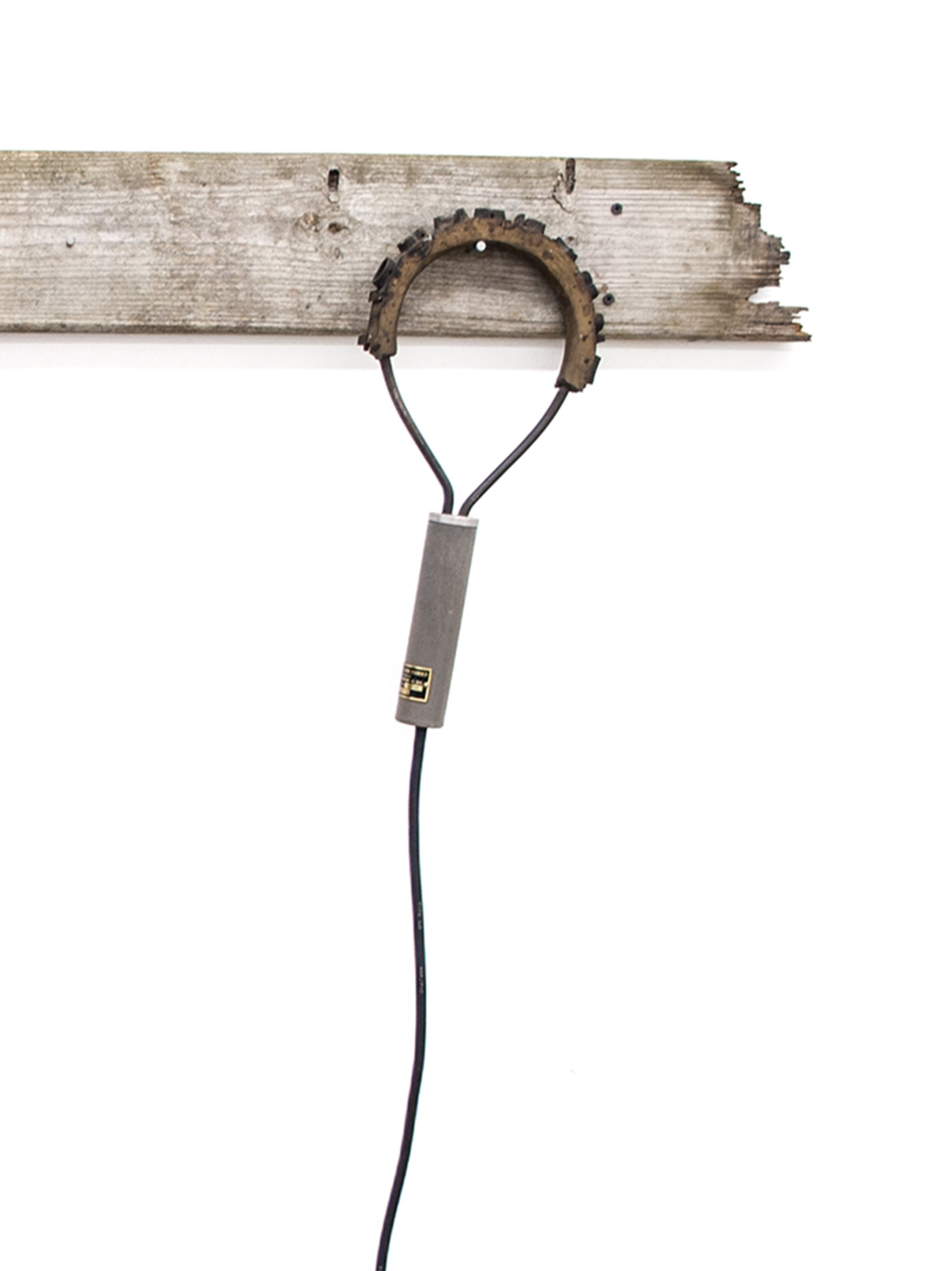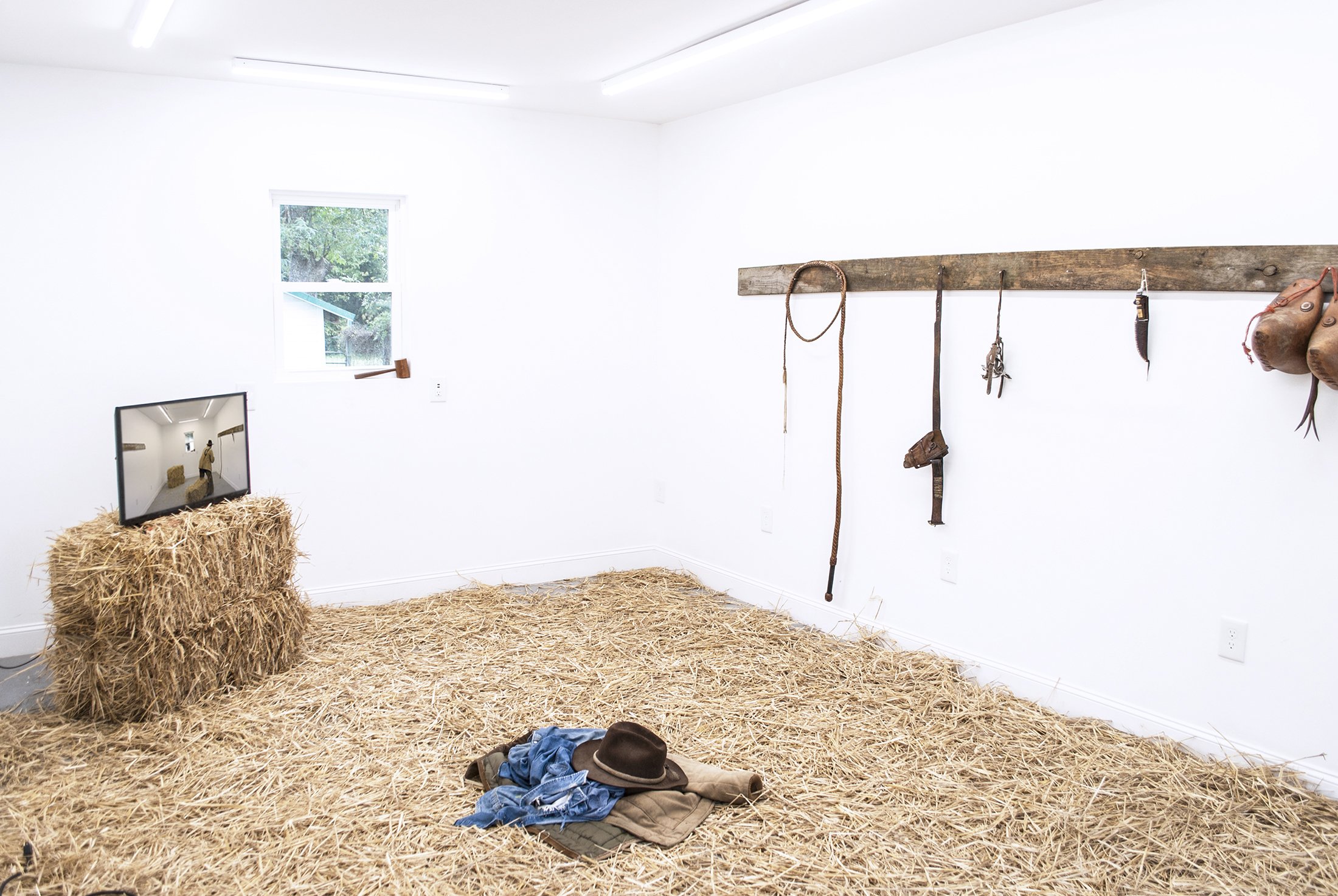Stone House Art Gallery is pleased to present new work by scholar and artist Brandon Sward in his first solo exhibition, How the West Was Lost. The exhibition in its present state displays the aftermath of a performance enacted by Sward, wherein he embodies a cowboy character using objects left behind at the Montana ranch of his late great uncle. The eight objects are displayed on two handmade racks made from semi-rotten wooden planks and construction nails, and are accompanied by a video of Sward’s performance with them. In the video, Sward dons his great uncle’s chaps and rancher attire while using the tools to interact with bales of straw in the gallery. By the end of the video, a single bale has been decimated and scattered throughout the space, having been straddled, whipped, stabbed, dragged, slept on, and danced through. The result uses material trace to explore relationships between gender, the family, and the afterlives of the American frontier in our national imagination
How the West Was Lost is on view by appointment only at SHAG through October 2021.


“From the conditions of frontier life came intellectual traits of profound importance. The works of travelers along each frontier from colonial days onward describe certain common traits, and these traits have… persisted as survivals in the place of their origin, even when a higher social organization succeeded. The result is that to the frontier the American intellect owes its striking characteristics. That coarseness and strength combined with acuteness and inquisitiveness; that practical, inventive turn of mind, quick to find expedients; that masterful grasp of material things, lacking in the artistic but powerful to effect great ends; that restless, nervous energy; that dominant individualism, working for good and for evil, and withal that buoyancy and exuberance which comes with freedom—these are the traits of the frontier… For a moment, at the frontier, the bonds of custom are broken and unrestraint is triumphant… each frontier did indeed furnish a new field of opportunity, a gate of escape from the bondage of the past; and freshness, and confidence, and scorn of older society, impatience of its restraints and its ideas, and indifference to its lessons, have accompanied the frontier. What the Mediterranean Sea was to the Greeks, breaking the bond of custom, offering new experiences, calling out new institutions and activities…. the ever retreating frontier has been to the United States… And now, four centuries from the discovery of America, at the end of a hundred years of life under the Constitution, the frontier has gone, and with its going has closed the first period of American history.”
-Frederick J. Turner, “The Significance of the Frontier in American History”


“Stanton Lewis Brannin, 83, passed away in his Big Timber home on Oct. 1. He was born on November 22, 1934, the youngest child of Lewis and Carrie Brannin.
“Stanton went to elementary school in Melville, and attended high school in Harlowton. He enjoyed any subjects that pertained to agriculture and animal husbandry. He was a member of FFA.
“He served his country with service in the military - two years in the National Guard and two years active duty. He briefly attended the University of Montana, but soon returned to his love of cowboying and ranching on the American Fork Ranch, near Two Dot, Montana.
“Stanton enjoyed ranch life above all else. He worked for the American Fork Ranch alongside his parents, while his father managed the ranch until 1975. When Lewis retired in 1975, Stanton stepped in. He would remain as the manager until he retired in 1999.
“Stanton’s cattle and horse sense was second to none. He was hand selected as a drover for the Montana Centennial Cattle Drive in 1989, a position he took seriously.
“Stanton enjoyed hobbies such as leather work, clock making, fishing and hunting, including hunting trips to Alaska. He also enjoyed rodeo roping and followed and supported many young cowboys as they perfected their skills.
“Stanton is preceded in death by his parents Lewis and Carrie Brannin. He is survived by his two sisters, LaVelle Brannin of Helena and Ivanelle White of Rhodes, Iowa. He is also survived by nieces and nephews, Gwen Knight (Jim Nettleton), Helena; Kim Wanderaas (Dave), Harlowton; Cynthia Whiteman (Tim), Bellingham, Washington; Koreen Chapman, Las Vegas, Nevada; Eric Knight (Lydia), Deer Lodge; Karisa Symonds (Dan), Gilbert, Arizona and William Sward, Colorado Springs, Colorado.
“Stanton lived most of his life in solitude on a ranch in Montana. He would gladly share his knowledge and experience if you took time to ask.”
-The Big Timber Pioneer, “Stanton Lewis Brannin”
Chaps
Leather, metal, thread
The word “chaps” is a shortened version of the Spanish chaparreras, which were in turn named after chaparral, a type of hard-leafed evergreen shrubland indigenous to the western coast of North America. The leather coverings consist of leggings and a belt, but no seat, worn over trousers to protect the legs while riding horseback. Like much of cowboy culture, chaps have been taken up by motorcyclists. Although this adoption is at least partially motivated by the danger of accidents, it’s difficult to ignore the resonance between the frontier and a subculture predicated on freedom, nonconformity, and individuality. And from there it’s not too far to Lana Del Rey, flying down an open highway, loose dark curls billowing gently in the wind.
Holster
Leather, metal, thread
For better or worse, the image of the Old West is deeply intertwined with firearms. Although gunfights were historically speaking uncommon occurrences, they captured the imagination of many and are a staple in folklore, fiction, and film from and about the period. We might understand this fascination, though, as a continuation of the chivalric codes associated with medieval Christendom, whereby masculinity, honor, and morality bled into one another like teardrops into tissues. Holsters like this were used to keep a weapon handy, should its services be needed.
Whip
Leather, rubber, twine
The length and flexibility of the whip allow it to be thrown in such a way that its tip exceeds the speed of sound, thus creating a small sonic boom. Despite its association with violence, ranchers relied upon whips primarily for their loudness and seldom if ever struck cattle with it. Nevertheless, it didn’t take long for the whip to be turned against human themselves, and flagellation remained a widespread form of corporal punishment well into the 19th century. Although the practice has subsided in much of the Western world, it continues to flourish there in religious and sadomasochistic contexts.
Brand
Metal, rubber, wire
Expressing ownership of that which, like an animal, moves can be challenging. One can create fences and lots and titles and deeds, but these are of limited utility in that fragile moment before banks and cops—or “civilisation” in general. The practice of branding livestock dates to Ancient Egypt but was brought to the Americas by the Spaniards. Indeed, the figure of the cowboy is heavily indebted to the vaquero tradition developed in what is now northern Mexico. This electric brand brings the device up to date with the conveniences of modern life, so that marking your property is as easy as plugging into a wall.
Spurs
Leather, metal
The etymology of “spur” can be traced to the Anglo-Saxon verb “to kick.” True to form, the spur is designed as a riding aid to be worn on the heels of one’s boots. While equestrian norms advocate for the subtle use of spurs to avoid harm and desensitization, they’re employed more aggressively in bull, saddle bronc, and bareback riding to replicate horse-breakers who would deliberately provoke their animals to buck. The spurs of contemporary rodeo, however, must be dull with free-turning rowels. We might, then, understand the modern-day spur as a neutered version of its once virile forefather (consider the Battle of the Golden Spurs in 1302, wherein the victorious Flemish hung the spurs of the defeated French in their churches as trophies).
Buckle
Metal
Due to their ability to hold swords and other weaponry, the belt buckle has long been associated with the military and, by extension, masculinity. As the tops of trousers moved closer to the waist during the early 20th century, belts became more common and with their newfound significance, buckles soon followed suit. The “Western style” immortalized by the eponymous genre were especially popular, becoming an award for rodeos, marathons, and other competitions.The plate of this buckle effectively serves as a stage upon which the struggle between Man and nature unfolds in all its glory.
Knife
Leather, metal, nacre
The knife is one of the earliest known tools, dating back to almost the advent of human history. Initially made of materials like bone and stone, the manufacture of blades was revolutionized by the discovery of metallurgy at the dawn of the Bronze Age. Through metalworking, the dreams of the alchemists were ushered into reality. As befitting such valuable objects, knives were often inlaid with precious stones or otherwise decorated.The handle of this knife has been set with nacre and the leather sheath embellished with delicate flowers, a quiet contrast with the dagger beneath.
Stirrups
Fur, leather, metal, plastic,
Although they can be steered with reins, horses can also be trained to respond to slight shifts of weight. Squeeze your calves inward to go forward, your knees to stop, both to go backwards. True to their portrayal by the Rolling Stones, horses do not naturally yield to human desire and must be “broken,” an unfortunate term that refers not to violence or humiliation per se, but rather the ongoing process through which they’re made docile. These leather stirrups are at once functional and stylish, providing leverage while shielding the foot.











